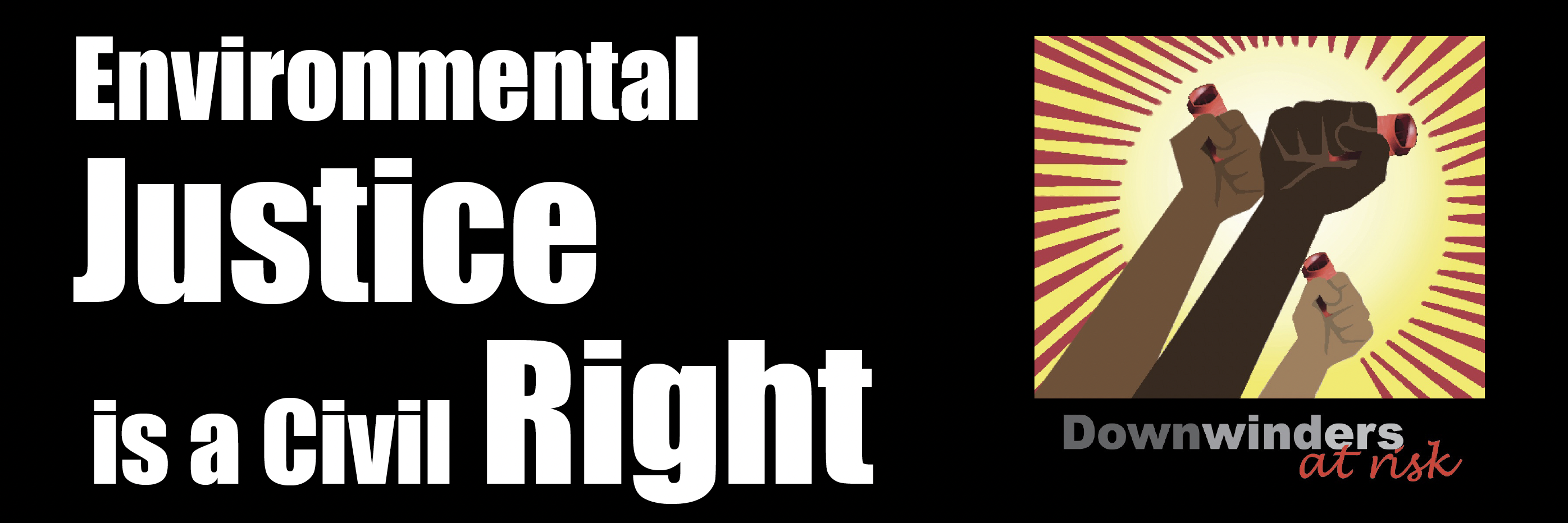Natural Gas
Red Alert for Dec 20th: Dallas Wants to Drill Like It’s 2009
 This is a heads-up to all Dallas residents: Dallas City Hall – the building, the people, everything – has climbed into a time machine and traveled all the way back to 2010.
This is a heads-up to all Dallas residents: Dallas City Hall – the building, the people, everything – has climbed into a time machine and traveled all the way back to 2010.
This has allowed the City council and staff to ignore citizen demands for a more protective gas drilling ordinance, the defeat of a council member who advocated drilling, the creation and conclusion of a task force for helping write a new ordinance, and a bunch of public hearings over the last two years – all so that Dallas City Hall can now just go ahead and do what the gas operators originally asked it to do at the beginning.
The first Special Use Permit request from a gas well operator to allow drilling in Dallas since 2010 will be on the agenda at the December 20th Dallas Plan Commission meeting at City Hall. It concerns a new request to drill by XTO (Exxon-Mobil) at the old Navel Air Station in southwest Dallas, near the Grand Prairie line, that was submitted on November 16th.
Time it's taken the City of Dallas to write a new drilling ordinance in Dallas: 24 months and counting
Time it took XTO to get its new drilling request heard despite not having that new ordinance yet: 20 days
You can read about the sudden jump into municipal action here behind the DMN paywall.
"XTO’s latest requests are apparently on a fast track, headed to the City Plan Commission….
A new, tougher Dallas drilling ordinance is in the works but has not been approved or even published for review, so the existing ordinance would govern the XTO applications, based on the city’s legal view that one set of rules should apply throughout the process."
Every Dallas City Council member appoints a representative to the City Plan Commission. Dallas residents should call their own City Council member (info here), or their Plan Commission appointee (download a list and contact info here) and tell them to reject this XTO request and any others that try to get processed before a new drilling ordinance is in place.
Here's the media release that Dallas Residents at Risk put out this morning about the sudden turn around:
Dallas Officials Consider Throwing Away Years of Work on New Gas Drilling Ordinance and Simply Let Fracking Begin
Have Mayor Rawlings and the Dallas City Council made a decision to move ahead with existing, pending and even new gas drilling applications without taking any action on the new “fracking” ordinance that has been in the works since 2010?
Two weeks ago, Exxon-owned gas company XTO filed a new gas drilling application—because their previous bid to drill at Hensley Field was denied by the Dallas City Plan Commission two years ago. Then the City Council appointed a special Gas Drilling Task Force, whose members met every week for eight months to consider proposals for a new ordinance. They finished their work in February of this year and issued their official recommendations, yet the City Council has not even begun drafting a new ordinance. The only rumored exception: City officials may consider simply changing the existing ordinance to allow fracking in floodplains, which would be necessary for gas company Trinity East to move ahead with its plans to drill in floodplain areas along the Trinity River. Neighborhood groups and environmental advocates say that’s unacceptable.
"This is the largest retreat of leadership that I can ever remember on such an important public health and environmental issue,” said Jim Schermbeck, Downwinders at Risk. “After three years of citizen complaints, a task force created, convened and concluded, expert and public testimony, and all Dallas residents get is a pair of shrugged shoulders from Mayor Rawlings and the Council? It's a bad joke."
There have been several major scientific studies surrounding the risks of fracking since Dallas officials began debating the new ordinance. Community leaders worry that new evidence pointing to health and safety risks for residents living near drilling sites will simply be ignored.
“So what if there's a 66% higher cancer risk within a half mile of a gas well; so what if already bad Dallas smog is made worse; so what if we still have no idea what chemicals will be used for fracking in Dallas,” said Claudia Meyer of the Mountain Creek Neighborhood Alliance. “It's as if the Mayor and Council are closing their eyes, plugging their ears, and desperately hoping to make all these new facts go away by just pretending they never happened.”
The new drilling applications leave Dallas officials exactly where they started, with the City Plan Commission being asked to shoulder the responsibility of deciding on whether to allow fracking to go forward. Advocates say the Commission should decline this offer and let the City Council do what it said it was going to do: Draft and pass a new gas drilling ordinance first.
“If we were only going to end up where we started, what was the point of a task force, or public hearings or anything that's happened since permitting stopped because the City wanted a new drilling ordinance,” said Zac Trahan with Texas Campaign for the Environment. “This is complete and utter dereliction of duty and public trust by the elected officials of this city on one of the most important public health and environmental questions to face Dallas in decades."
Cuts in Methane and PM Pollution Can Slow Climate Change
 In an opinion piece in The Daily Climate, Michael MacCraken, the chief scientist for the DC-based Climate Institute advocates an end-run strategy to avoid the political logjam over large CO2 cuts as a way to fight global warming. He suggests concentrating on reducing Methane and Particulate Matter pollution as a way to "appreciably slow the rate of warming over the next several decades." He cites an earlier UN study that concluded:
In an opinion piece in The Daily Climate, Michael MacCraken, the chief scientist for the DC-based Climate Institute advocates an end-run strategy to avoid the political logjam over large CO2 cuts as a way to fight global warming. He suggests concentrating on reducing Methane and Particulate Matter pollution as a way to "appreciably slow the rate of warming over the next several decades." He cites an earlier UN study that concluded:
"…a moderately aggressive international emissions control program focused on the short-lived compounds could roughly halve the projected warming between the present and 2050. While slowing the warming through this approach might seem to also offer additional time for cutting CO2 emissions, this is not the case. Instead, these actions are more appropriately viewed as partially making up for earlier policy delays.
For the United States to do its share, aggressive limits on CO2 emissions must be complemented by aggressive limits of emissions of short-lived species. In particular, the Environmental Protection Agency will need to be more aggressive in cutting short-lived emissions, particularly of methane from the oil and gas industry, and making its voluntary methane and black carbon programs mandatory.
With climate change so far along, the question now is no longer whether impacts can be avoided, but rather how bad they will become. What we do with respect to both mitigation and adaptation will control that outcome. The longer we wait, the worse the impacts and sharper the required energy transition."
While methane gradually breaks down in the atmosphere, forming carbon dioxide, it has 100 times the warming potential of carbon dioxide for the first 20 years it’s exposed to the environment. A study by Cornell University Environmental Biology Professor Robert Howarth found between four and eight percent of the methane produced by a fracking well is leaked into the atmosphere during the well’s lifetime. For all the immediate environmental benefits of natural gas, the methods used for its extraction could create a larger greenhouse footprint than oil or coal over time.
EPA is considering a new national PM pollution standard because of its public health impacts and should use the opportunity to win deeper cuts that offer so many "co-benefits." Every reduction in soot is now doubly important. Cars, cement kilns, coal plants, and just about any industrial boiler or furnace spews out PM. They all need to be targeted as part of a larger effort to bring this kind of pollution under better control.
This impact on global warming is also one more reason why Dallas residents should be demanding that the city incorporate some kind of "off-sets" policy regarding new oil and gas air pollution as part of a new City drilling ordinance. Not only can it hep reduce smog and some of the toxins released by the drilling and processing of natural gas; it can also provide some needed help for climate change at a time when the city is just squeaking by its own greenhouse gas reduction goals.
Australian Study: Fracking Releases 3X Normal Greenhouse Gases
S cientists from Southern Cross University in Australia found levels of greenhouse gases in that country's largest fracking play that were three times normal background levels, and higher than those recorded anywhere else on the planet.
cientists from Southern Cross University in Australia found levels of greenhouse gases in that country's largest fracking play that were three times normal background levels, and higher than those recorded anywhere else on the planet.
“The concentrations here are higher than any measured in gas fields anywhere else that I can think of, including in Russia,” Damien Maher, a biochemist who helped conduct the tests, told the Sydney Morning Herald."
Air contaminants being monitored included methane ad carbon dioxide.
"Some scientists surmise that the excess levels are due to seepage of the gas through displaced soil and aquifers that carry “fugitive” emissions released by fracking a mile or more below ground. Carbon cycle expert Peter Rayner of the University of Melbourne told the Australian Broadcasting Corp. that the elevated gas levels were probably due to “emissions that escape from the intended process of production.”
Not surprisingly, there are health complaints form residents living in and near the wells in the play.
"Helen Redmond, a physician with the New South Wales chapter of Doctors for the Environment, cited rising complaints of rashes, nausea, headaches and nose bleeds among people living close to the Tara gas fields.”Hydrocarbon exposure cannot be ruled out as a cause without much more comprehensive investigation,” she told the Sydney newspaper…."
Back here in DFW, Dallas is still stalling on writing a new gas drilling ordinance that citizens want to prompt the nation's first local policy of off-setting greenhouse gas pollution. And many observers believe DFW just failed its second clean air plan in five years because of the impact of rising gas industry pollution.
Fracking the Vote
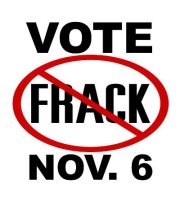 Sharon has the rundown on how various local initiatives about fracking fared yesterday.
Sharon has the rundown on how various local initiatives about fracking fared yesterday.
2nd TCEQ Clean Air Plan in Four Years Fails, Leaves Air Dirtier
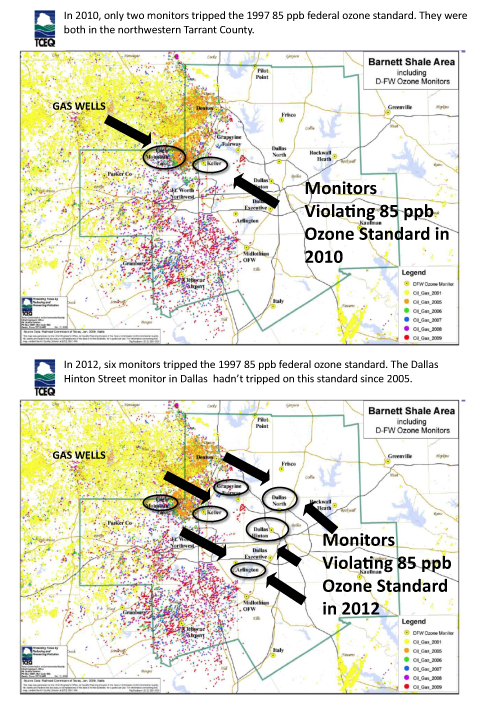 For the second time in four years a state-designed clean air plan to bring safe and legal air to DFW residents has failed, missing its goal by an even wider margin than on its first try, and leaving local air quality worse than when it started.
For the second time in four years a state-designed clean air plan to bring safe and legal air to DFW residents has failed, missing its goal by an even wider margin than on its first try, and leaving local air quality worse than when it started.
November 1st marked the official end of the eight-month 2012 ozone season. According to the Texas Commission on Environmental Quality, or TCEQ, its plan was supposed to deliver record-breaking clean air to DFW this summer on its way to bringing the region into compliance with the Clean Air Act for the first time in two decades.
Causality or Coincidence: Oil & Gas Agency Info Tech “Stuck in Mid-90’s”
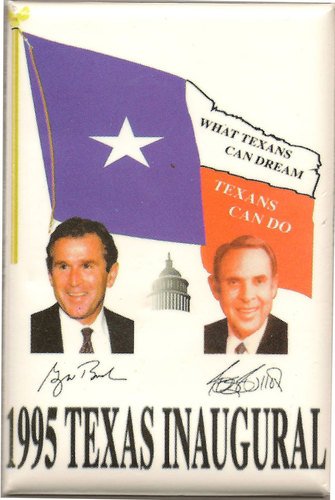 Here's a radio report by KUHF out of Houston that features DFW's own Rita Beving and Rep. Lon Burnam talking about the sorry state of IT at the Railroad Commission. You can't get a good map of a pipeline, look up violations, or report problems in a timely way. One of the RRC Commissioners themselves is quoted as saying their information technology is stuck in the mid-1990's. There was an important election around then that has had a big impact on how state government is run, but we can't quite recall…
Here's a radio report by KUHF out of Houston that features DFW's own Rita Beving and Rep. Lon Burnam talking about the sorry state of IT at the Railroad Commission. You can't get a good map of a pipeline, look up violations, or report problems in a timely way. One of the RRC Commissioners themselves is quoted as saying their information technology is stuck in the mid-1990's. There was an important election around then that has had a big impact on how state government is run, but we can't quite recall…
Groups Petition EPA to Include Frackers in Toxic Release Inventory
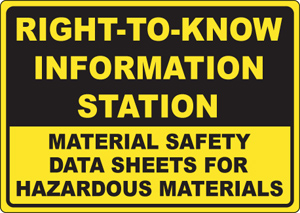 A dozen environmental and citizens groups filed a petition with EPA on Wednesday to close a loophole in the law and include oil and gas pollution in the annual system of self-reporting emissions and releases with which most US industrial polluters already have to comply.
A dozen environmental and citizens groups filed a petition with EPA on Wednesday to close a loophole in the law and include oil and gas pollution in the annual system of self-reporting emissions and releases with which most US industrial polluters already have to comply.
The Toxic Release Inventory, or TRI, was created in the wake of the horrible Union Carbide plant accident in Bhopal, India, that killed 2500 people immediately, and caused another 16,000 deaths in the months and years since. It's supposed to keep track of all hazardous and toxic chemicals on-site or released by industry at every facility regulated – power plants, cement plants, refineries, chemical plants of all kinds, lead smelters, etc. TRI numbers are self-reported once a year by the companies operating the facilities, based on EPA formulas. These numbers are then made available to the public via the EPA's own TRI Explorer site, or independent groups like RTK.net run by the OMB Watch folks.
However, the TRI leaves out a very large industrial segment – oil and gas drilling. This exemption might have made some sense 30 years ago, but it doesn't now, especially given the dramatic rise in modern-day fracking techniques that use large volumes of hazardous and toxic materials.
If EPA regulators went along, that would fold in not just drilling but also related activities at the wellhead, before oil and gas is ready for transport to customers and refiners. Under environmentalists’ petition, companies would be forced to report chemicals released in drilling and completing wells as well as compression operations and processing at fractionators that split gas into separate components.
Disclosures also would be required from hydraulic fracturing operations, in which mixtures of water, sand and chemicals are pumped underground to release natural gas and oil from dense rock formations.
Eric Schaeffer, director of the Environmental Integrity Project that spearheaded the campaign, stressed that the foundation of the TRI was a deeply held belief that the public has a right to know what kind of pollutants are being released from neighboring facilities.
We’re asking the EPA to “honor those values,” Schaeffer said. “EPA has the power to add other sectors that ought to be reporting, and we’re asking them today to exercise the authority.”
Jane Davenport, a senior attorney with the Delaware Riverkeeper Network, said the reporting mandate should apply broadly.
“The oil and gas industry should not get a pass from statutes that apply to other industries,” she said, noting that the industry already enjoys some exemptions from provisions in the Clean Water Act and other environmental laws.
This may not sound like a radical step, but don't discount the power of public disclosure. TRI numbers from the Midlothian cement plant helped Downwiders show that the kilns were the largest industrial and toxic polluters in North Texas, proved the companies were not telling the truth when they said there were no toxic emissions from waste-burning or cement-making, and allowed citizens to track the volumes of pollution coming out of the kilns and analyze those numbers for trends. That's why the oil and gas industry will be fighting tooth and nail to keep the loophole open. Even something as innocuous as disclosing your own chemical information is threatening to operations that have enjoyed historic protections from the public spotlight.
Start the Weekend Off Right: “Don’t Frack My Fairway” Rig Protest Today
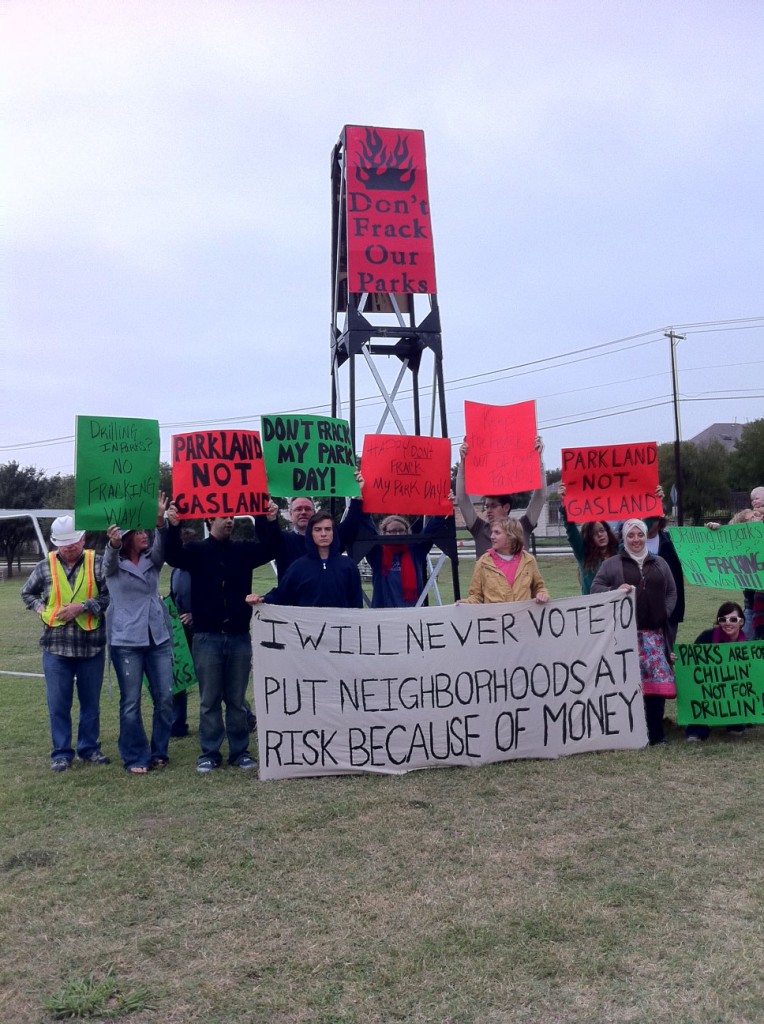 Looking for something to do this Friday late afternoon? Why not join concerned Dallas citizens for a fun little encounter with officialdom out at the newly made-over "Luna Vista" municipal golf course by North I-35.
Looking for something to do this Friday late afternoon? Why not join concerned Dallas citizens for a fun little encounter with officialdom out at the newly made-over "Luna Vista" municipal golf course by North I-35.
Members of Dallas Residents at Risk – a coalition that includes Downwinders – will be showing up at the grand re-opening of what was formally known as the LB Houston Golf Course with their new 15-foot tall mock drilling rig in tow. They'll be trying to set it up next to the course clubhouse where ceremonies attracting City Councilmember Monica Alonzo, Dallas Park Board Vice President Gabriel Soto and Dallas Park and Recreation officials will be taking place.
The course is city parkland and at least three sites within the course have already been leased by the city to Trinity East for fracking – including one adjacent to the driving range.
After two years and a list of task force recommendations, the Dallas City Council is still wrestling with the problems created in 2006 when they took over $30 million from gas operators for leases on city-owned property. The decision was not publicized and there were no public hearings.
Despite not drilling on those sites in the intervening period, gas operators are continuing to seek permission to exploit them. Many of those leases are either in parkland like the Luna Vista sites, or in the Trinity River floodplain. City Council member Sheffie Kadane and others have endorsed park drilling, saying the land is underutilized.
Yes, it's going to be a little chilly. But we need to confront City Hall at every opportunity and this is a prime one. None of the city's press materials that feature beautiful pictures of the course mentions that those views will be marred by taller-than-15-foot drilling rigs. It's up to citizens to raise these issues.
When: 4:30 – 5:30 today/Friday Where: Luna Vista Golf Course Clubhouse, 11223 Luna Road, Dallas
“You got your fracking fluid in my cement!” Kiln Disposal of Drilling Wastes.
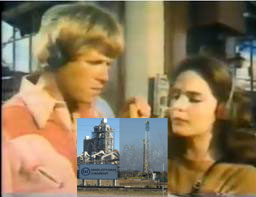 It was inevitable. Like chocolate and peanut butter. Like rats and the plague.
It was inevitable. Like chocolate and peanut butter. Like rats and the plague.
Two notoriously polluting industries find solace in each other's ability to scratch each other's dirty, irritating itches.
Cement plants are always looking for ways to get paid to burn other people's garbage. It takes a lot of energy to fire a 20-foot flame at 2000 degrees 24/7 in order to cook rock. It also takes a lot of "additives". That's why cement plants started burning other companies' hazardous wastes in the 70's and 80's. Because of a loophole in federal law, 50-year old cement plants with no modern pollution controls were allowed to charge for burning highly toxic wastes from refineries and chemical plants that were otherwise supposed to be going to fully-regulated hazardous waste disposal sites.
But those official sites cost more to use, and the cement plants cost so little. That's right, cement plants charged these polluters to dispose of their wastes, but not more than the incinerators or landfills with all the bells and whistles of "regulation." In this way, cement plant operators double dip – they don't have to shell out as much for fuel they'd have to buy, and they get paid a profit to be a Dispos-All for industry. And by the way, industry calls this "recycling."
Because of the persistence of Downwinders at Risk and other citizens' groups, this loophole has been slowly but surely closing, meaning less and less hazardous waste is being burned in US cement kilns. From a peak of almost 30 kilns burning toxics in the in the 1990's, we're now down to less than a dozen. But to take the place of this lucrative lost market, cement plants across the country are turning to "non-hazardous" waste to burn. Tires, but also municipal garbage, plastic wastes, used oils, shingles, car parts and other kinds of wastes. TXI's new permit allows the burning of a dozen different kinds of industrial wastes at its huge kiln in Midlothian.
While these wastes are classified as "non-hazardous," when they come in the front gate of a kiln, it turns out they can release a lot of toxic pollution when they're incinerated. Metals like lead and cadmium and arsenic that don't burn (consult your High School physics textbook) are present. So are PCB's that have Dioxin. But burning plastic or chlorinated wastes means you can generate Dioxins even without having them present in the wastes to begin with. There's also Mercury in some of the wastes from cars that TXI and other kilns wants to burn.
So you have the release of exactly the same kinds toxic pollution you were concerned about with the burning of officially-classified hazardous wastes. But now, it's taking place "legally," – or at least it is until the law hasn't catches-up with the consequences of this kind of low-rent disposal operation. Have a waste you want to get rid of? Send it to your local neighborhood cement plant. They'll burn anything.
Enter the Natural Gas industry. They've been getting a lot of bad PR lately about their own waste problems. They have billions of gallons of what they like to call "fracking fluid," and what the rest of us would call "hazardous wastes" that's so toxic it must be disposed of in a deep underground injection well after only being used once, isolated from the rest of the earth's environment forever. But because of some well-placed loopholes, this "fracking fluid" is not considered "official" hazardous waste under federal rules. It will just unofficially injure you with its toxins.
As it turns out, injecting billions of gallons of "non-hazardous" toxic liquid under extremely high pressure near deep underground faults is a sure way to generate earthquakes. And that's what's been happening. Not only in North Texas, but other places where there are lots of injection wells. There was another small one last night in Midlothian, right down the highway from a large deep injection well near Venus. Along with the fact that most fracking fluid cannot be or is not "recycled" now and can only be used once before disposal, the fracking fluid generated by the gas industry has turned into an embarrassing sore point.
If only there was some other way the gas industry could dispose of their drilling wastes. If only they could appear to be more environmentally-friendly and save money at the same time……
And there you have the genesis of a happy marriage made in polluter heaven. I have a facility that needs stuff to burn and mix, and I'm not that particular about what the stuff has in it. You have lots of stuff that needs to be burned, er, "recycled" and you spend less when you send it to a facility like mine not specifically built to do that job. Everybody wins!
"The use of drilling wastes and muds is most preferable in cement kilns, as a cement kiln can be an attractive, less expensive alternative to a rotary kiln. In cement kilns, drilling wastes with oily components can be used in a fuel-blending program to substitute for fuel that would otherwise be needed to fire the kiln.
Cement kiln temperatures (1,400 to 1,500 degrees C) and residence times are sufficient to achieve thermal destruction of organics. Cement kilns may also have pollution control devices to minimize emissions. The ash resulting from waste combustion becomes incorporated into the cement matrix, providing aluminum, silica, clay, and other minerals typically added in the cement raw material feed stream.
Recent studies have shown that it is feasible to use such drilling waste as substitute fuel in a cement plant. The drilling mud can be processed by a centrifuge to separate remaining water, compressed by a screw into a solid pump and conveyed.
The cement companies can contribute to sustainability also by improving their own internal practices such as improving energy efficiency and implementing recycling programs. Businesses can show commitments to sustainability through voluntary adopting the concepts of social and environmental responsibilities, implementing cleaner production practices, and accepting extended responsibilities for their products."
For veterans of The Cement Wars of the 1990's this rhetoric is certainly recycled. Cement Plants are Long, Hot and Good for America! Cement plants are the best disposal devices ever. They just make everything go "poof." That's why they were built specifically to dispose of wastes of all kinds – oh wait. nope. They were built to make cement. But how great is it that they can make an entire sideline business out of dealing with, and spewing toxic chemicals into the environment?
Even though the specific article deals with the Middle East, is there any question that a cement plant in Texas or Pennsylvania, or Ohio won't try to make the case for accepting drilling wastes, if they haven't already? The permit modification TXI received to burn plastics and car wastes from the State of Texas required no public notice at all. Citizens only found out after the fact. There are only about a dozen players left in the international cement market. If they're discussing this in Egypt and Saudi Arabia, chances are they're talking about it in Zurich, Heidelberg, and Midlothian too.
Developments like this are why its important to tell the EPA it's making a big mistake to delay and change its cement plant toxic emission rules. The industry's "inputs" are changing rapidly. Two years is too long. We need the protection of those new rules now. If you haven't already clicked and sent EPA an e-mail saying you oppose this delay, the "official" comment period is over, but it couldn't hurt for the folks in DC to see your "unofficial" opposition.
It's also a lesson in why "everything is connected." Don't live near a gas well? If you live in DFW, chances are you live downwind of a kiln that could be burning the wastes of gas wells.
Yes Virginia, There is a Pro-Cancer Lobby
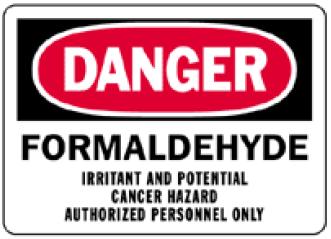 The New York Times' Nicolas Kristof, who's established himself as one the nation's leading editorialist on the harms of what he calls "Big Chem," has another excellent piece in the Sunday edition.
The New York Times' Nicolas Kristof, who's established himself as one the nation's leading editorialist on the harms of what he calls "Big Chem," has another excellent piece in the Sunday edition.
Using the curious case of Formaldehyde, the carcinogen that isn't one according to the people who make money manufacturing it, Kristoff draws a portrait of the kind of industry-fueled professional obfuscation that Big Tobacco, Big Oil and Every other Big Industry of the last 60 years has used to escape necessary regulation.
Part of this strategy is to block, delay and bury information that proves your product's guilt, and so it is with Formaldehyde, something most of us think we only run across in High School biology labs. As it turns out, the chemicals is used in a wide variety of products and our homes are full of it. Our general exposure to formaldehyde has increased. This use and exposure has risen even as the World Health Organization and American scientists have concluded that formaldehyde causes cancer.
And so a seemingly innocuous document like the 500-page "Report on Carcinogens" from the National Institutes of Health becomes a real threat to the manufactured "uncertainty" the chemical industry has spent so much to construct.
“Formaldehyde is known to be a human carcinogen,” declared the most recent Report on Carcinogens, published in 2011. Previous editions had listed it only as a suspected carcinogen, but the newer report, citing many studies of human and animal exposure to formaldehyde, made the case that it was time to stop equivocating."
This conclusion made the report an instant target. Industry got its supporters in the house to demand a follow-up study for Formaldehyde and that no other Reports on Carcinogens be published with the new consensus language on its cancer-causing impacts.
So a chemical that the science says is clearly a carcinogen is still being sold in lots of household products as if it was perfectly safe thanks to folks who, collectively, make up what might be called the "pro-cancer lobby."
Besides all of us being exposed to Formaldehyde through consumer products, people who live in places where natural gas is being mined, like the Barnett Shale, as well as those downwind of waste-burning cement plants, like the ones in Midlothian, get dosed with more of the stuff. So, you know, we're doubly-blessed in DFW.
